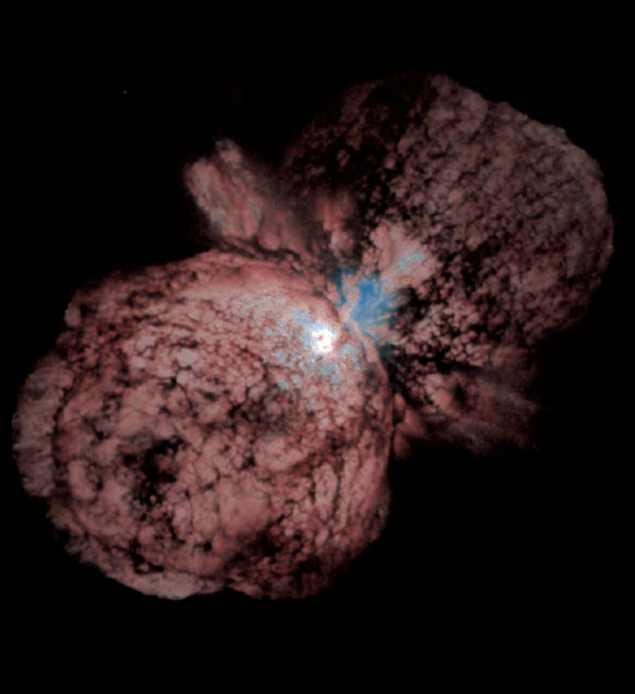
Some 180 years ago, a relatively normal star called Eta Carinae suddenly brightened to become the second brightest star in the sky, before almost disappearing at the end of the 19th century. The sudden brightening and subsequent disappearance, recorded by astronomer John Herschel, suggested that the star had undergone a supernova explosion, leaving behind a black hole. More recent observations have shown, however, that the star still exists – ruling out the supernova hypothesis. Even more remarkably, what remains is a binary system of two stars, the more massive of which is surrounded by a large nebula.
Although supernovae imposters such as Eta Carinea are now known to occur in other galaxies, this event – known as the Great Eruption – appeared relatively close to Earth at a distance of around 7500 light years. It is therefore a perfect laboratory in which to study what exactly happens when stars appear to survive a supernova.
The fate of Eta Carinae has remained mysterious, but since the turn of the millennium clues have emerged in echoes of the light emitted during the Great Eruption. While the light observed in the 19th century travelled directly from the system towards Earth, other light initially travelled towards distant clouds surrounding the stars before being reflected in our direction. In 2003, the light echoes from this event were bright enough to be observed using the moderate-sized telescopes at the Cerro Tololo Inter-American Observatory in Chile, while the different gas clouds reflecting the light were observed more recently using the larger scale Magellan Observatory and the Gemini South Observatory, also located in Chile. By comparing historical records of the variability observed in the 19th century with the variability of the light reflected from a gas cloud, it can be determined how far in the past astronomers are observing the explosion.
Now, a team led by Nathan Smith of the University of Arizona in Tucson has studied the spectra of the light echo in more detail using the 6.5 m Magellan telescopes and found that it matches observations during the 1840s and 1850s, when the Great Eruption was at its peak. Spectral analysis of the reflected light indicates that initially matter was ejected at relatively low velocities of 150–200 km–1, while during the 1850s some matter was travelling at speeds of 10,000–20,000 km–1. The data are compatible with a system that first ejects material as one star brightens followed by more violent ejection from an explosion.
Smith and collaborators claim that the scenario which best matches the data, including information about the age and mass of the two remaining stars, is that the system originally consisted of three stars. The two closest stars initially interacted to form one massive star, while the donor star moved further away, losing mass and thereby increasing the radius of its orbit around the massive star. The gravitational field of the far-away donor star would have caused the orbiting third star to dramatically change orbit, forcing it to spiral into the massive central star. In doing so, its gravitational interactions with the massive star caused it to shed large amounts of matter as it started to burn brighter. Finally, the binary system merged, causing a violent explosion where large amounts of stellar material were ejected at large velocities towards the earlier ejected material. As the fast ejecta smashed into the slower moving ejecta, a bright object was formed on the night sky that was visible for many years during the 1850s. The remaining binary system still lights up every few years as the old donor star moves through the nebula left over from the merger.
The new details about the evolution of this complex and relatively nearby system not only teach us more about what was observed by Herschel almost two centuries ago, but also provide valuable information about the evolution of massive stars, binary and triple systems, and the nature of the supernovae imposters.
Further reading
N Smith et al. 2018 MNRAS 480 1457.
N Smith et al. 2018 MNRAS 480 1466.








